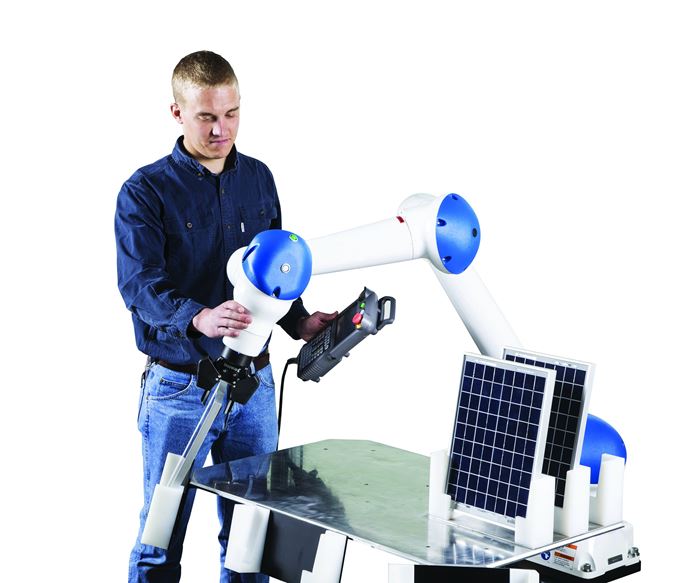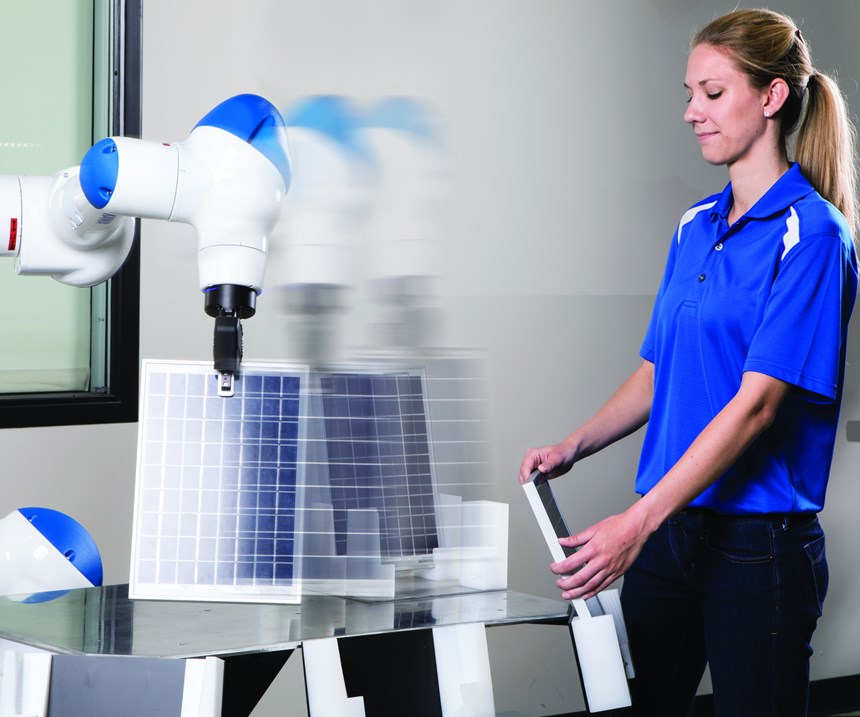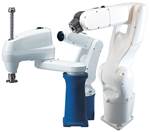The True Cost of Cobots
Defining expectations and determining the ROI of collaborative robots help guide sound investment choices.
Collaborative robots, also called “cobots,” are the newest trend in robotics. A cobot is a special type of industrial robot designed to work with, or closely to, humans. Various technologies can be implemented to reduce the speed of a cobot’s motion when a worker enters its work area, or to sense when the cobot encounters a human and stops or moves away. While cobots have been around for many years, it seems that almost every company and industry has taken some initiative in looking to use the technology. In moldmaking, that could be material handling or machine tending.
But why? The claim is that cobots cost less, provide more safety for workers and can quickly deliver a remarkable return on investment (ROI). Is this true, or is there more than meets the eye?
Companies should approach the question of whether to use cobots in the same way they approach other business decisions. Cobots can provide tremendous value, but their implementation necessitates proper application. For example, companies need to consider whether the cobots would have jobs that bring the cobots near humans, jobs with smaller payloads or jobs without high-speed cycle time requirements. Do not get caught up in the hype. Evaluate the bottom line, and consider both direct and indirect costs and benefits.
When determining the ROI, be sure to identify the objectives of the project first. The objectives could be both qualitative and quantitative, but even the qualitative ones should have value associated with them. For example, are you looking to reduce costs, improve productivity or increase product quality? These can all be assigned a metric. Offset the benefits with the true cost of implementation, which includes the initial purchase, reduced throughput, labor impact and cobot lifespan. Remember that businesses make good investments when they have a strong understanding and definition of expectations and costs.
The following include some of the key features of collaborative technology that reveal the most important considerations a business should have for evaluating that technology’s ROI. The purpose of this article is not to show you how to calculate the ROI, or even give you a basic spreadsheet model. This article outlines the factors that will help you evaluate ROI.
Lowered costs. Everyone expects collaborative robots to cost less than what they are currently using. The reason is they are typically smaller, simpler to install, may not require extensive integration with other technology in the facility and can be implemented without a large investment in safety infrastructure. But is that accurate? For the most part, yes. However, even these key selling points have their caveats.
Self-integration is a key part of collaborative robots. Still, not everyone has the knowledge and expertise to implement them. Sure, unpacking a unit and getting it running in an hour or so sounds great, but many do not realize how much knowledge it takes to understand the impact a cobot will have on the rest of the organization. It is therefore vital to pay attention to the cost of integration within existing infrastructures and to any process changes. For example, introducing a cobot may require installing additional communication lines and programming to allow that cobot to communicate with other technology in the facility.
It is also important to recognize the fact that a safe robot does not mean a safe system. You need to consider the overall expense of cobot implementation. Although cobots are thought of as ‘fenceless robots,’ it is more accurate to say that they can be fenceless. The specific application or product being manufactured may require unique end-of-arm tooling, fencing or other safety equipment that is not typically associated with a cobot. You need to determine if you will save a significant amount of money using the sensors or force-limiting technology that comes with cobots, as opposed to fencing or curtains.
A proper risk assessment will help with that decision. This involves evaluating the entire process and all equipment to identify and determine the risk level. Keep in mind that a proper risk assessment now can help identify safety concerns and provide significant savings later.
Less intrusion. Floor space is a scarce commodity in any business. Cobots, because of their small, compact size, tend to require less space. They also tend to have smaller payload capability, and workers can move them easily without a fork lift. This translates directly into cost savings when they can coexist in confined spaces where it would be impossible to implement a traditional, industrial robot. That is a big plus in the ROI calculation.
Greater flexibility. It is difficult to put a dollar value on flexibility. If the cobot can be redeployed or moved to perform other tasks, then a company can save on acquiring a second or third unit. But, consider the time and effort required to redeploy the cobot to a different location for a different application. Redeploying the cobot may affect downtime enough that it warrants the purchase of an additional unit.
Beneficial trade-offs. When implementing any type of new technology, there may be trade-offs that affect ROI either directly or indirectly. For example, safety features such as power and force-limiting sensors provide a safer environment by protecting workers in the event that they come into contact with the robot. That is why the collaboration feature exists, but it means that they operate more slowly than traditional robots. Slower cycle times may affect throughput or overall productivity.
Less expensive equipment may also mean less robust equipment. Is the cobot built to last? You certainly do not want your ROI influenced by the need to replace the robot in three to five years. Your ROI may be affected if the unit is not designed with a platform to last or built to withstand the rigors of your specific environment. Units that are not designed with a lasting platform or that are not built to withstand the rigors of a specific environment may impact ROI.
Many users claim that cobots are easy to use, and often they mean that cobots are easy to set up and to start using quickly. This may be true, but this ease of use usually means less functionality. For example, the user interface may be great for the novice. But, as the expertise of a user grows, he or she will want greater capability for more complex needs. Therefore, it is important to acknowledge that expanding the use of a cobot may require hiring someone with more experience or even advanced technical programing skills.
These benefits and costs of collaborative technology highlight all that is required to make sound investment decisions. Hopefully, this information can help you determine the value that collaborative technology may provide to your company.
Related Content
Machine Hammer Peening Automates Mold Polishing
A polishing automation solution eliminates hand work, accelerates milling operations and controls surface geometries.
Read MoreMaking Mentoring Work | MMT Chat Part 2
Three of the TK Mold and Engineering team in Romeo, Michigan join me for Part 2 of this MMT Chat on mentorship by sharing how the AMBA’s Meet a Mentor Program works, lessons learned (and applied) and the way your shop can join this effort.
Read MoreHow to Use Scientific Maintenance for More Accurate Mold and Part Troubleshooting
Discover how adopting scientific maintenance approaches helps improve mold lifespan, minimize failures, and optimize production outcomes.
Read MoreMMT Chats: The Connection Between Additive Manufacturing Education and ROI
This MMT Chat continues the conversation with Action Mold and Machining, as two members of the Additive Manufacturing team dig a little deeper into AM education, AM’s return on investment and the facility and equipment requirements to implement AM properly.
Read MoreRead Next
10 Considerations for Choosing a Robot
Knowing what to look for is essential when comparing and evaluating robots from different manufacturers.
Read MoreHow to Use Continuing Education to Remain Competitive in Moldmaking
Continued training helps moldmakers make tooling decisions and properly use the latest cutting tool to efficiently machine high-quality molds.
Read MoreAre You a Moldmaker Considering 3D Printing? Consider the 3D Printing Workshop at NPE2024
Presentations will cover 3D printing for mold tooling, material innovation, product development, bridge production and full-scale, high-volume additive manufacturing.
Read More






















